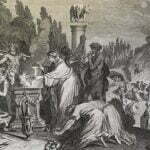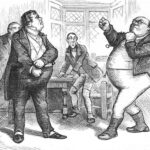A review of Hail, Holy Queen. By Scott Hahn.
Doubleday, 2001.
I realize that I am taking a risk. As a Protestant reviewing a decidedly Catholic book for a partly Catholic audience, I walk on shaky ground. Yet there may be a method to my madness. I share a number of similarities with Scott Hahn. In many ways I have had a similar spiritual pilgrimage to him. We even attended the same American Protestant seminary – Gordon Conwell in Boston. He graduated with highest honors a few years before I graduated with highest honors. But whereas he converted from Evangelicalism to Catholicism, I have remained in the Evangelical camp. So this review reflects some major theological differences.
At the outset it can be said that Roman Catholics will (or should) like this book. It is an impressive defense of the veneration to Mary afforded by the Catholic church. As a convert to Catholicism, Hahn is both a passionate and an articulate defender of Catholic doctrinal teaching. And as a former Evangelical apologist, he is a skilled debater and thoroughly conversant with the biblical and theological issues at stake.
What does a Protestant make of his work? As can be imagined, differences of opinion will abound. One key issue is that of authority. Protestants tend to look to Scripture as the final word of authority. Thus the doctrine of Mary, like any other, is judged from that basis. And Protestants will argue that Scripture says very little about Mary. Indeed, except for Acts 1:14, Mary is mentioned nowhere else outside of the gospels. Hahn takes a different tack however. He argues that Mary “fills the pages of Scripture from the beginning of the first book through the end of the last” (p. 9). He makes this case in large measure from his understanding of typology. He argues that “Marion types abound in the Old Testament” (p. 25). Protestants however would claim that Hahn is stretching a long bow here.
Typology of course is both a biblical hermeneutical device as well as an occasion for much mischief. Some of the early church fathers tended to overdo the method (as in Origen’s allegorical excesses). Indeed, Hahn even admits that “typology has its own pitfalls, and its abuses have led some scholars far afield and others into heresy” (p. 90).
However, Hahn sees many OT types, including the ark of the covenant, as early representations of Mary. Of course no clear New Testament affirmation of such a depiction can be marshaled. Hahn nonetheless spends much of his time seeking to find Mary throughout Scripture, especially in the final book of the New Testament: Revelation.
The book of Revelation is arguably the most symbolic of all biblical books, making it the most difficult to interpret. Many wise exegetes, including Calvin (who wrote commentaries on most of the books of the Bible), refused to touch it. Thus it needs to be approached with caution. Yet Hahn rushes headlong into the book, assuring us that Mary can be found on almost every page. Specifically, Rev. 11 and 12 is meant to contain much in relation to Mary.
Yet a cursory knowledge of the history of the interpretation of the book shows that many views have been attempted, with none commanding supreme allegiance. For example, while many Patristic interpreters regarded Rev. 12 as referring to Mary, many others regarded it as referring to the church. Other interpretations have been offered. One’s theological bent tends to determine how this and other difficult passages are interpreted.
Another approach offered by Hahn in his defense of Mary is to appeal to the early church fathers. The truth is, we have a mixed bag here as well. For example, it appears that some doctrines, like the bodily assumption, was not taught during the Patristic period. Further, the idea that Rev. 12:1, which speaks of a “woman clothed with the sun”, refers to Mary and her assumption, does not seem to be held by any of the early fathers through the fourth century. Instead, they saw the woman as the church. Likewise, the doctrine of the immaculate conception does not seem to appear until the fifth century (and was rejected by Anselm, and Aquinas, among others).
Hahn also offers this intriguing defense of the Catholic reverence for Mary: he argues that “a family is incomplete without a loving mother” (p. 27). This implies that without Mary, we are somehow living in a broken family. Part of the Roman Catholic defense is the idea of Mary as the mother of God. This is not the place to go into the complexities of the early Church fathers and their formulations of Christology. But when the fifth-century fathers used the phrase, it was in order to uphold Christ’s deity, and only later did it become a title to uphold honor to Mary. At Chalcedon for example “theotokos” (God-bearer) was used, but the supplementary phrase by Cyril, “mater theou” (Mother of God) was rejected.
Hahn also makes this claim: “As Mary birthed Christ to the world, so the Church births believers, ‘other Christs,’ to each generation. As the Church becomes mother to believers in baptism, so Mary becomes mother to believers as brothers of Christ” (p. 66). While the thought may have a nice ring to it, unfortunately, there is not one scrap of evidence anywhere in all of Scripture to support the idea. Indeed, the NT nowhere calls believers “other Christs”. It would be sacrilegious to do so. Such talk does not elevate believers but debases Christ. And nowhere is Mary said to be the mother of believers.
In fact, if the doctrine were true, we would expect the rest of the NT to make much of it. But as already noted, Mary is virtually unheard of outside the gospels. She simply disappears from view. Indeed, given her almost complete absence in the rest of Scripture, it seems hard to sustain any major support for her.
Again, the issue boils down to one of authority. For Protestants, who regard Scripture as the sole source of authority (while appreciating the role of tradition and the church), to promulgate doctrines without an iota of Scriptural support is simply not on. Such a methodology may be how cults operate, but Biblical believers cannot go down that path.
Other issues could be raised. He argues the traditional Catholic stance that Mary was a perpetual virgin and that Jesus had no brothers or sisters. There are a number of biblical problems with these positions, which even many Catholic scholars admit.
As to Mary’s perpetual virginity, the biblical support is sorely lacking. Even one of the greatest recent Catholic New Testament scholars, the late Raymond Brown, can speak of the “dubious methodology of assuming without proof Lucan knowledge of Mary’s lifetime virginity”.
There are other problems with the idea of perpetual virginity. As Hahn even admits, “vowed celibacy was almost unheard of in ancient Israel” (p. 107). Indeed, the idea of a married virgin is a biblical oxymoron. Both the OT and the NT make it clear that any idea of a married virgin is unacceptable. Indeed, in 1 Corinthians 7 Paul makes the opposite case, that marriage does, and should, involve sexual activity.
Hahn tires to avoid the argument by saying vowed celibacy did exist – as in the apostle Paul. But that is not the issue. The issue is one of celibacy in marriage. This is almost unheard of in ancient Israel.
Concerning the issue of bothers and sisters of Jesus, the usual Catholic response is to say that the references (found in Matt. 12:46-47; 13:55-56; John 2:12, Gal. 1:19, etc.) refer to cousins, not actual brothers and sisters. Raymond Brown says this is “a thesis that in truth faces enormous difficulties”. And Roman Catholic scholar J.P. Meier argues that “from a purely philological and historical point of view, the most probable opinion is that the brothers and sisters of Jesus were his siblings”.
The linguistic problem for example, is that nowhere in the New Testament does the word adelphos (brother) mean cousin. Indeed, the NT has another word, anepsios which is used for cousin (as in Col. 4:10). While adelphos can mean relative, the contexts in the gospels make blood brother the logical usage.
Also, Hahn, like other Catholic apologists, makes much of passages like Luke 1:42 where Elizabeth exclaims: “Blessed are you among women, and blessed is the child you will bear!” These and similar verses are used to prove the high degree of veneration (some might argue, worship) shown to Mary.
But contextual considerations, along with Old Testament stories which Matthew and Luke appeal to, make such claims unlikely. For example, in the Old Testament we find similar descriptions of Godly women. In Judges 5:24 we find the prophet Deborah praising Jael: “Blessed be Jael among women”. And in Judith 13:18 (an apocryphal, but non-canonical book according to Protestants), Uzziah says of Judith, “Blest of God Most High are you, daughter, above all the women of the earth”.
Appeal is also made to Luke 1:48 where Mary says,. “From now on all generations will call me blessed”. But as Catholic scholar Joseph Fitzmyer explains, this is “not because of any intrinsic, personal holiness or merit, but because of him whom she is bearing”. And again, it is not unique to Mary. A similar phrase can be found in the case of Leah: “How blessed I am! All women will count me blessed” (Gen. 30:13).
As Brown puts it, “This OT background suggests that Mary’s blessing is not purely a personal one. She has a role in God’s plan for His people because she has conceived the Messiah who will be the glory of Israel (Luke 2:32)”.
Scripture seems to contain passages where Jesus rebukes his mother or claims made about her. But these texts are given a different spin by Catholic apologists. For example, we read in Luke 11:27-28 these words: “As Jesus was saying these things, a woman in the crowd called out, ‘Blessed is the mother who gave you birth and nursed you.’ He replied, ‘Blessed rather are those who hear the word of God and obey it’.”
Catholic apologists maintain that the word translated “rather” can be used in different senses. True enough. But most careful NT scholars recognise that here it is being used as a correction or modification. At best we can say that if Jesus wanted on this occasion to elevate Mary, he could clearly have chosen less ambiguous terminology.
Another passage where Jesus appears to rebuke his mother is John 2:3-4 “And when they wanted wine, the mother of Jesus said to him, ‘They have no wine’. Jesus said to her, ‘Woman, what have I to do with you?’ My hour is not yet come.” Amazingly, Hahn can argue that other occurrences of these words do “not signify reproach or disrespect. Quite the opposite: it conveys respect and even deference” (p. 36). But as most scholars acknowledge, the use of the formula is one that conveys disagreement, with the point in question being disputed. Indeed, the idiom always denotes a distance between the two parties. As Australian NT scholar Leon Morris writes, “Jesus’ words make it clear that there was something of a barrier between them”. Says Brown, the phrase can mean either hostility or simple disengagement.
And even the way he addresses her raises questions. While to call someone “woman” may not be discourteous, it is a strange way to refer to one’s mother. It certainly seems distant and impersonal. And it was nowhere a common practice, whether Hebrew or Greek.
Moreover, on other occasions, Jesus seems to have reminded his parents of their limits, due to his mission. In Luke 2:49, for example, Jesus responds` to their question this way, “Why were you searching for me? Didn’t you know I had to be in my Father’s house?” Not exactly what one would expect of a polite Jewish boy of twelve. Fitzmyer notes “something of a reproach” in his response.
Other issues could be raised. But in sum, for Protestants, it seems that there is too little Scriptural data to substantiate the claims of Hahn. Indeed, he admits that many of the key doctrines (the assumption into heaven and the immaculate conception) are instead “implicit in the biblical text” (p. 92). Thus the lack of clarity regarding the biblical evidence makes Hahn’s case seem weak. Indeed to Protestants, speculation and eisegesis (reading into the text) seem to make up the bulk of his argumentation.
As I said, Catholics will find this a welcome addition to the growing arsenal of Catholic apologetics (of which Hahn has been a major contributor). Protestants will find much of interest here, and some may be persuaded. But many will remain unconvinced. But the debate is worth pursuing, and Hahn has positioned himself as a formidable defender of his new found faith. For both sides of the debate, anyone interested in the subject of Mary will find this a stimulating and challenging book.
[2155 words]




















Many, many thanks indeed!
While I fear very much to “rush in headlong” as you say, I must admit that I have read at least 4 books written by Mr. Hahn
The book “Letter & Spirit” is being read for the 3rd time presently.
I am not a scholar by a “long stretch of the bow”, and yet I do think that in the books I have read I do not believe that Hahn was rash to rush in so headlong!
For me I accept that the gospels have referred to Jesus Christ as the “son of Mary” Then St. Paul says that “He was born of woman” and the doctrine of the Church establishes that Jesus is “true God and true man”!
And so that is good enough for me, and because I am born of woman I would do anything in my power for the love of my mother
I would try tto do the same for Mary, the mother of Jesus Christ but can you in a thousand years think up and write down how much more will Jesus Christ – “true God and true man” do for His own mother?
Nowhere in the Bible have I found, yet, where Jesus Christ did say to Mary, “I love you mother”, but do you really believe that he does not?
Finally in the 10 Commandments there is “honour your father and your mother” , and as you commented that Mr. Hahn is passionate in doing what he does.
You have also accepted that different people will interpret the same data in many different ways and that seems to be the reason why there are so many many many different protestant groups in the world today.
Again, many thanks, Nik A Morris
Bill, as you say, “Again, the issue boils down to one of authority.” Scott Hahn’s first book, Rome Sweet Home, deals with this issue and is ultimately the clincher for him coming into the Catholic faith.
Anna von Marburg
Thanks Anna
Yes I am aware of the book. But at this point my intention is not to re-enter the centuries old debate on these issues. Nor do I believe I will likely shift my position as Hahn has done. So for now we hopefully can agree to disagree here.
Bless you,
Bill Muehlenberg, CultureWatch
Thanks Bill. I appreciate your fairness and objectivity. Deception is a funny thing. But rather than “weigh into the debate”, I take the lesson to be ever more vigilant in watchful in my own life, lest I should stumble on any point.
Thanks again for your hard work to give us this synopsis.
Mike Miles
Thanks Mike
Bill Muehlenberg, CultureWatch
Thanks for the article – as I read through it I couldn’t help thinking that Hahn’s arguments were largely based on eisegetical hermeneutics, which you stated yourself.
I really can’t understand how someone can receive such a comprehensive education in evangelical protestantism, which champions the exegetical method, to then dismiss all that in favour of a truly worrying approach to scripture.
The mind boggles.